LAD/Blog #37: FDR’s Executive Order 9066
LAD/Blog #37: FDR’s Executive Order 9066
President FDR passed Executive Order 9066 on February 19, 1942 to create military areas that were used as “relocation centers” for Japanese Americans following his declaration of war due to Pearl Harbor. He designated the Secretary of War (and other military commanders who he authorized) to be in charge of this task, and keep the people in these areas fed and with shelter/adequate accommodations. He said these people could do whatever seemed “advisable to enforce compliance with the restrictions applicable to each Military area.” Additionally, FDR authorized Executive Departments and Federal Agencies to help the leaders, which could include supplying medical aid, food, clothing, transportation, the use of facilities, and more. This executive order was seen in the story “Home was a Horse Stall,” which told the heartbreaking experience of a Japanese American family who was sent to one of these areas. Sox, the main character, as well as others in the camp, struggled with the conditions they were forced to live in, and the discrimination they had to endure, to no fault of their own. I believe that after Pearl Harbor/FDR declared war it was reasonable to take precautions and strengthen defenses in the US, but not to the extent that Executive Order 9066 took it.

Executive Order 9066

Indian Appropriations Act of 1851 (synthesis):
Executive Order 9066 was very similar to the Indian Appropriations Act of 1851, which established the reservation system for Native Americans, as both took large groups of people and removed them from their land, forcing them to go where the government told them.
President FDR passed Executive Order 9066 on February 19, 1942 to create military areas that were used as “relocation centers” for Japanese Americans following his declaration of war due to Pearl Harbor. He designated the Secretary of War (and other military commanders who he authorized) to be in charge of this task, and keep the people in these areas fed and with shelter/adequate accommodations. He said these people could do whatever seemed “advisable to enforce compliance with the restrictions applicable to each Military area.” Additionally, FDR authorized Executive Departments and Federal Agencies to help the leaders, which could include supplying medical aid, food, clothing, transportation, the use of facilities, and more. This executive order was seen in the story “Home was a Horse Stall,” which told the heartbreaking experience of a Japanese American family who was sent to one of these areas. Sox, the main character, as well as others in the camp, struggled with the conditions they were forced to live in, and the discrimination they had to endure, to no fault of their own. I believe that after Pearl Harbor/FDR declared war it was reasonable to take precautions and strengthen defenses in the US, but not to the extent that Executive Order 9066 took it.

Executive Order 9066
Indian Appropriations Act of 1851 (synthesis):
Executive Order 9066 was very similar to the Indian Appropriations Act of 1851, which established the reservation system for Native Americans, as both took large groups of people and removed them from their land, forcing them to go where the government told them.
Comments
Post a Comment